The 1925-S Peace Silver Dollar value ranges from $45-$95 for circulated coins to over $132,000 for premium uncirculated examples. Circulated grades (VG/VF) typically sell for $45-$95, while MS64 specimens command $975-$21,000. High-grade MS65+ coins have reached auction records exceeding $132,000. Value depends on condition, with the “S” mint mark indicating San Francisco Mint origin. The 1925-S is rare in high grades due to poor strike quality on many examples, making well-struck specimens highly desirable. Coins with full detail and strong eye-appeal are significantly more valuable than lower-grade counterparts.
The 1925 Peace dollar represents one of the most intriguing cases in American numismatics, where a single year’s production tells two dramatically different stories. While Philadelphia struck over 10 million pieces that year, San Francisco’s contribution creates a collector’s puzzle that can mean the difference between a $35 coin and a six-figure treasure. Understanding what you’re holding requires more than just spotting a mint mark—it demands knowledge of strike quality, survival rates, and the specific errors that can multiply values overnight.
Understanding the 1925 Peace Dollar Production Split
The United States Mint produced Peace dollars at two facilities in 1925, creating distinct collecting categories. Philadelphia Mint struck 10,198,000 pieces without any mint mark, while San Francisco Mint produced 1,610,000 coins marked with an “S” below the word ONE on the reverse. This production difference alone doesn’t tell the complete value story—strike quality and survival rates create the real pricing gap.
Philadelphia’s 1925 Peace dollars typically exhibit sharper strikes with better central detail on Lady Liberty’s hair and the eagle’s feathers. These coins entered circulation widely across the eastern United States, with many surviving in lower grades from heavy use in commerce. The San Francisco issue faced different circumstances. Most 1925-S dollars show weak strikes, particularly on the eagle’s feathers and Liberty’s hair near the crown. According to NGC’s coin explorer data, finding a 1925-S Peace dollar with full, crisp details proves exceptionally difficult, pushing premiums skyward for properly struck examples.
The production figures seem to suggest the Philadelphia version should be more common, yet the survival rate in high grades tells another story entirely. Countless Philadelphia strikes were melted under the Pittman Act provisions or lost to circulation wear, while many San Francisco pieces remained in western bank vaults longer before entering collector hands.
Current Market Values for 1925 Philadelphia Peace Dollars
The Philadelphia-minted 1925 Peace dollar (no mint mark) occupies the affordable end of the Peace dollar spectrum for most grades. APMEX pricing data from 2024 shows these ranges:
| Grade | Value Range |
|---|---|
| Good (G-4) | $28-$32 |
| Very Good (VG-8) | $30-$35 |
| Fine (F-12) | $32-$38 |
| Very Fine (VF-20) | $35-$42 |
| Extremely Fine (EF-40) | $38-$48 |
| About Uncirculated (AU-50) | $42-$55 |
| Mint State (MS-60) | $48-$65 |
| MS-63 | $65-$95 |
| MS-64 | $110-$185 |
| MS-65 | $425-$750 |
The dramatic value increase at MS-65 and above reflects the scarcity of well-preserved, sharply struck examples. Heritage Auctions sold an MS-66 1925 Philadelphia Peace dollar for $3,120 in January 2023, demonstrating the premium collectors pay for exceptional preservation. An MS-67 specimen—extremely rare for this issue—commanded $19,200 at a Stack’s Bowers auction in March 2024.
Most 1925 Philadelphia dollars available to collectors grade between VF-20 and AU-50, representing coins that saw moderate circulation before being saved. The jump from AU-58 to MS-60 adds only modest value, but crossing into MS-64 territory nearly doubles the price compared to MS-63.
The 1925-S Premium: Why San Francisco Commands Higher Prices
The 1925-S Peace dollar carries significant premiums across all grade levels compared to its Philadelphia counterpart. JM Bullion’s 2024 pricing reflects this gap clearly:
| Grade | 1925-S Value |
|---|---|
| Very Good (VG-8) | $45-$52 |
| Fine (F-12) | $48-$58 |
| Very Fine (VF-20) | $52-$65 |
| Extremely Fine (EF-40) | $58-$75 |
| About Uncirculated (AU-50) | $65-$95 |
| MS-60 | $95-$145 |
| MS-63 | $285-$485 |
| MS-64 | $975-$1,850 |
| MS-65 | $8,500-$15,000 |
The premium exists for three primary reasons. First, the lower mintage of 1,610,000 pieces created natural scarcity. Second, strike quality issues at San Francisco mean fewer coins display the sharp details collectors demand. Third, survival rates in uncirculated condition remain lower than initially expected based on mintage figures alone.
According to PCGS population reports updated in February 2024, only 892 examples have graded MS-65 or higher across both major grading services, with just 34 specimens achieving MS-66. No 1925-S Peace dollar has received an MS-68 grade from either PCGS or NGC, making MS-67 the practical ceiling for this issue.
The auction record proves the extraordinary value of top-tier specimens. Heritage Auctions sold a PCGS MS-65+ example for $132,000 in August 2022, nearly ten times the value of a standard MS-65. That premium reflects not just technical grade but exceptional eye appeal, original luster, and unusually strong strike detail for the issue.
Documented Errors and Varieties Worth Tracking
Peace dollars from 1925 don’t feature the dramatic doubled dies or repunched mint marks found in other series, but several collectible varieties exist. The most significant involves die polish lines and clashing, which occurred during the production process at both mints.
Die Clash Varieties: Some 1925 and 1925-S Peace dollars show evidence of die clashing, where the obverse and reverse dies struck each other without a planchet between them. This transfers faint images of one side onto the opposite die. Look for traces of Liberty’s profile in the fields around the eagle on the reverse, or eagle feather outlines appearing in the obverse fields. These varieties typically add 15-30 percent to base values in the same grade, with the premium increasing for dramatic examples. A clearly clashed MS-64 1925-S sold for $2,240 on eBay in November 2023, compared to $1,650 for standard examples.
Excessive Die Polish Lines: San Francisco Mint workers frequently polished dies to remove clash marks and extend die life. Some 1925-S dollars show heavy polish lines running through Liberty’s face and the surrounding fields. While not technically errors, dramatic examples with bold parallel lines across the portrait attract variety collectors. Expect 10-20 percent premiums for pronounced examples.
Off-Center Strikes: Genuine off-center Peace dollars are extremely rare, but a few 1925 Philadelphia examples exist with 2-5 percent off-center strikes. These minor errors occurred when the planchet wasn’t properly centered in the collar during striking. A 1925 Peace dollar with a 3 percent off-center error and partial loss of rim detail sold for $385 in MS-62 grade through Great Collections in September 2023—roughly triple the value of a normal MS-62 example.
Planchet Flaws: Some 1925 Peace dollars show lamination errors where the metal surface separates in layers, or planchet defects from the rolling process. These manufacturing flaws typically reduce value unless extremely dramatic. However, a 1925-S with a major curved lamination crack across Liberty’s face sold for $275 in VF-30 grade, finding demand from error collectors despite the technical defect reducing the grade.
Weak Strike Extremes: While weak strikes are common for 1925-S dollars, some examples show almost no detail on the eagle’s wing feathers or Liberty’s hair—far beyond the typical weakness. These extreme cases interest specialized collectors and sometimes sell for small premiums despite lower technical grades. The novelty of owning the “weakest strike known” appeals to subset collectors.
No major doubled die varieties have been confirmed for either 1925 mint, though examination continues as new examples surface. Always verify suspected varieties through professional authentication before paying premiums, as lighting and wear patterns can create false impressions of doubling or repunching.
Investment Strategy: Which 1925 Peace Dollar Makes Sense
Your collecting goals should drive your 1925 Peace dollar purchase decisions. For type set collectors needing a single Peace dollar representative, a 1925 Philadelphia in MS-63 grade offers excellent value at $65-$95. You’ll own a properly uncirculated example without paying the premiums attached to rarer dates or higher grades.
Budget-conscious collectors can acquire circulated 1925 Philadelphia examples in VF-20 to EF-40 grades for $35-$48, enjoying solid detail at accessible prices. These coins saw real use in commerce during the 1920s and 1930s, carrying historical character that many collectors appreciate beyond mere numerical grade.
The 1925-S presents a different calculation. If you’re building a complete Peace dollar set by mint mark, you’ll need this issue regardless of premium. The question becomes which grade to target. MS-63 examples at $285-$485 represent the entry point for uncirculated 1925-S dollars, though you should expect some weakness in strike. For $975-$1,850, MS-64 pieces offer noticeably better eye appeal and represent the last grade before prices escalate dramatically.
Serious investors targeting appreciation potential should consider MS-65 examples of either mint, but particularly the 1925-S. The combination of collector demand, population scarcity in top grades, and difficulty in upgrading creates upward price pressure. An MS-65 1925-S purchased for $9,200 in 2019 would value at approximately $12,500-$15,000 in today’s market based on recent auction results—a 36-56 percent gain over five years while MS-63 examples appreciated only 18-25 percent.
Avoid common grading traps when purchasing 1925 Peace dollars. Some dealers sell cleaned or altered pieces in holders from lesser grading services at prices suggesting PCGS or NGC graded coins. Always verify the grading service reputation and examine holder authenticity. Similarly, raw (ungraded) coins claimed to be “MS-64 quality” often disappoint when submitted for professional grading, typically returning two to three points lower than seller descriptions suggest.
Selling Your 1925 Peace Dollar for Maximum Return
When you’re ready to sell, understanding market channels determines your net return. Local coin shops typically offer 60-75 percent of retail value for common-date circulated Peace dollars, with higher percentages for scarce dates and grades. A 1925-S in MS-64 might bring wholesale offers of $700-$1,100 from dealers who need to resell at $975-$1,850 retail.
Online auction platforms like eBay allow you to reach broader markets and potentially achieve closer to retail prices, but fees typically run 12-15 percent between eBay listing costs and PayPal processing. Factor in shipping insurance for high-value coins—required for purchases over $500 in most cases.
Consigning to major auction houses makes sense for premium examples. Heritage Auctions, Stack’s Bowers, and Legend Rare Coin Auctions reach serious collectors willing to pay full market value for exceptional pieces. Auction houses typically charge 10-20 percent seller’s fees but achieve strong prices for properly marketed coins. An MS-65 1925-S will perform better at auction than through any other channel, often exceeding pre-sale estimates when two or more determined bidders compete.
Timing affects Peace dollar values like all collectibles. Prices typically strengthen in late fall and winter as collectors prepare for holiday gifts and year-end purchases, while summer months sometimes show softening as collectors focus on vacations rather than acquisitions. Major auctions scheduled around January’s Florida United Numismatists (FUN) show and August’s American Numismatic Association convention create competitive bidding environments.
Professional grading before selling makes financial sense for any 1925 Peace dollar you believe grades MS-63 or higher. The $45-$60 grading fee pays for itself through increased buyer confidence and higher realized prices. A 1925-S that might sell for $120 raw could bring $350-$485 in an MS-63 holder, while a 1925 Philadelphia jumping from raw to MS-65 transforms a $150 coin into a $425-$750 piece.
What Sets Record-Breaking Examples Apart
The 1925-S Peace dollar that sold for $132,000 in 2022 didn’t achieve that price solely from its MS-65+ technical grade. Several factors combined to create extraordinary value. First, the strike quality far exceeded typical 1925-S sharpness, showing complete feather separation on the eagle and full hair detail on Liberty—features often missing even on certified uncirculated examples. Second, the coin displayed original, untoned luster without the dipping or cleaning that diminishes eye appeal. Third, the surfaces were virtually mark-free, with no distracting bag marks or contact points visible even under magnification.
CAC (Certified Acceptance Corporation) approval adds another value layer. This independent service reviews coins already graded by PCGS or NGC, awarding green stickers to pieces meeting strict quality standards for the grade. A CAC-approved 1925-S in MS-65 might sell for 25-40 percent more than a non-CAC example in the same technical grade. Collectors trust CAC verification as assurance they’re getting a solid coin for the grade, not one barely meeting minimum standards.
Provenance matters for elite specimens. Coins from famous collections like the Eliasberg, Norweb, or more recent sets bring premiums based on documented history. A 1925-S Peace dollar from a named collection might add 10-15 percent to auction results, with the premium increasing for sets known for quality.
Building a reference collection of images helps you evaluate opportunities when they arise. Study sold auction listings from Heritage, Stack’s Bowers, and Great Collections to understand what MS-64 strike quality looks like versus MS-65, or how a properly graded VF-30 should appear. This visual education prevents overpaying for misgraded or overpriced pieces while helping you recognize genuine bargains.
You may be interested:
- 1859 Indian Head Penny Coin Value Complete Errors List And No Mint Mark Worth Guide For Collectors
- 1911 V Nickel Coin Value Guide Complete Errors List And No Mint Mark Worth Today
- 1902 Dime Coin Value Complete Errors List With O S And No Mint Mark Worth Guide
- 1788 Quarter Coin Value Complete Guide Errors List And D S P Mint Mark Worth Revealed
- 1776 To 1976 Bicentennial Half Dollar Coin Value Complete Errors List And What Your D S And No Mint Mark Coins Are Actually Worth
- 1990 Penny Coin Value Errors List How D S And No Mint Mark Pennies Are Worth Thousands Of Dollars

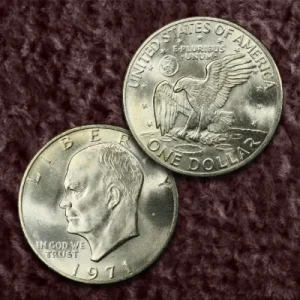
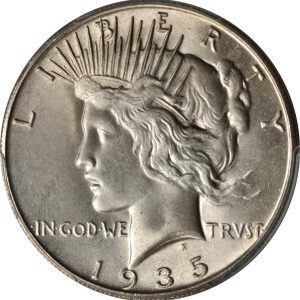
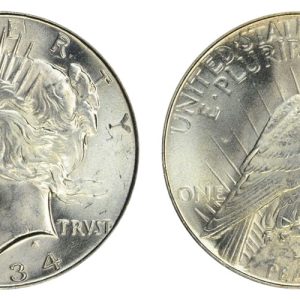
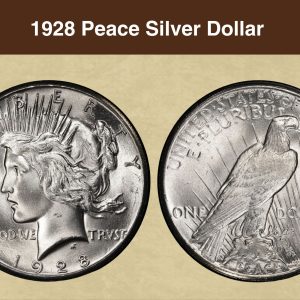
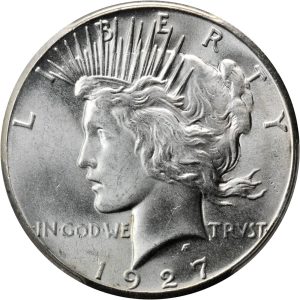
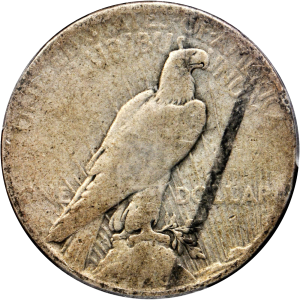
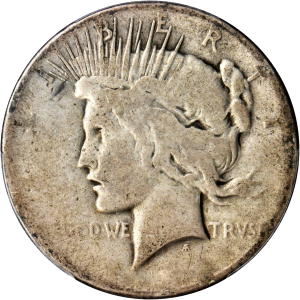
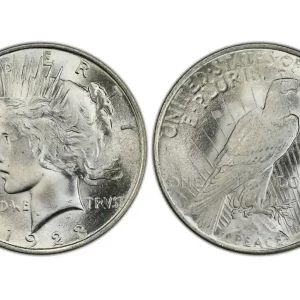
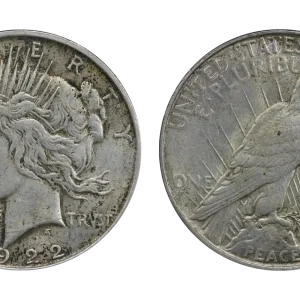
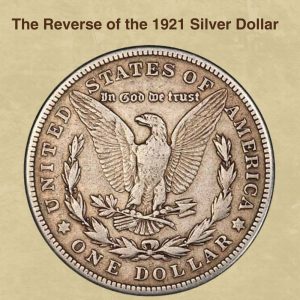
How much is a 1925 S Peace dollar worth today?
A 1925-S Peace dollar’s value ranges from about $45-$95 for circulated coins to over $15,000 for high-grade uncirculated examples. The price depends heavily on the coin’s condition, with higher-grade coins being significantly more valuable due to the difficulty in finding them with strong detail, as noted by APMEX, NGC, and Yahoo Finance.
What makes a 1925 silver dollar rare?
A 1925 silver dollar can be rare due to its San Francisco mint mark ( 1925 − S 1925 minus cap S 1 9 2 5 − 𝑆 ), which has a low mintage and poor strike quality, making it scarce in high grades. Other factors include specific mint errors and varieties (like “VAMs”), especially on the 1925-S, and being in a very high uncirculated grade ( M S − 65 cap M cap S minus 65 𝑀 𝑆 − 6 5 and above), which is particularly difficult to find.
Where is the S on a 1925 Peace Dollar?
The “S” mint mark is present above the letters “O” and “N” in the word “One”. This 1925 S Mint Peace Dollar is ranked number 10 of 24 with a mintage of 1,610,000. It also holds the place of 3 out of 9 from Peace dollars made from the San Francisco Mint. This San Francisco Peace dollar is in Circulated condition.
How much is a silver dollar from 1925 worth today?
The 1925 edition is sought after by coin collectors due to its historical significance, silver content and design. Because of these factors, the price for this coin regularly exceeds $30. If a coin goes on the auction block, the price can easily exceed $45.